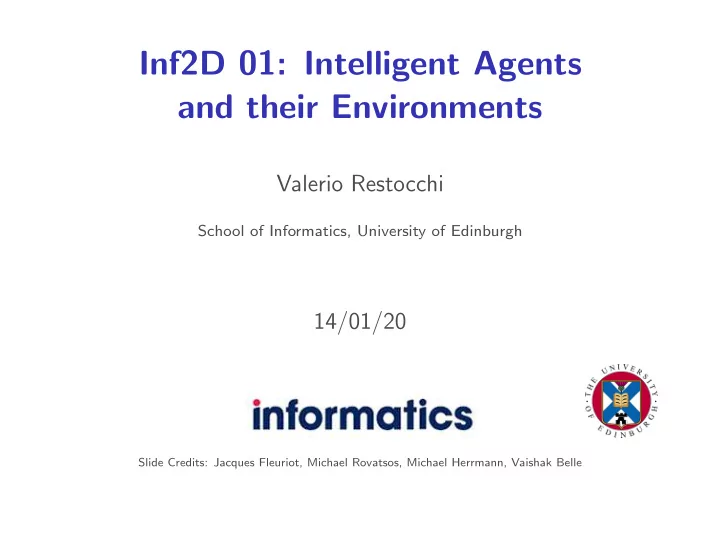

Inf2D 01: Intelligent Agents and their Environments Valerio Restocchi School of Informatics, University of Edinburgh 14/01/20 Slide Credits: Jacques Fleuriot, Michael Rovatsos, Michael Herrmann, Vaishak Belle
Structure of Intelligent Agents An agent: − Perceives its environment, − Through its sensors, − Then achieves its goals − By acting on its environment via actuators. 2
Structure of Intelligent Agents 3
Examples of Agents 1 − Agent: mail sorting robot − Environment: conveyor belt of letters − Goals: route letter into correct bin − Percepts: array of pixel intensities − Actions: route letter into bin Side info: https://en.wikipedia.org/wiki/Mail sorter 4
Examples of Agents 2 − Agent: intelligent house − Environment: ◮ occupants enter and leave house, ◮ occupants enter and leave rooms; ◮ daily variation in outside light and temperature − Goals: occupants warm, room lights are on when room is occupied, house energy efficient − Percepts: signals from temperature sensor, movement sensor, clock, sound sensor − Actions: room heaters on/off, lights on/off Side info: https://en.wikipedia.org/wiki/Home automation 5
Examples of Agents 3 − Agent: autonomous car. − Environment: streets, other vehicles, pedestrians, traffic signals/lights/signs. − Goals: safe, fast, legal trip. − Percepts: camera, GPS signals, speedometer, sonar. − Actions: steer, accelerate, brake. Side info: https://en.wikipedia.org/wiki/Autonomous car 6
Simple Reflex Agents − Action depends only on immediate percepts. − Implement by condition-action rules. − Example: ◮ Agent: Mail sorting robot ◮ Environment: Conveyor belt of letters ◮ Rule: e.g. city=Edinburgh → put Scotland bag https://en.wikipedia.org/wiki/Intelligent agent 7
Simple Reflex Agents 8
Model-Based Reflex Agents − Action may depend on history or unperceived aspects of the world. − Need to maintain internal world model. − Example: ◮ Agent: robot vacuum cleaner ◮ Environment: dirty room, furniture. ◮ Model: map of room, which areas already cleaned. ◮ Sensor/model trade-off. 9
Model-Based Agents 10
Goal-Based Agents − Agents so far have fixed, implicit goals. − We want agents with variable goals. − Forming plans to achieve goals is later topic. − Example: ◮ Agent: household service robot ◮ Environment: house & people. ◮ Goals: clean clothes, tidy room, table laid, etc. 11
Goal-Based Agents 12
Utility-Based Agents − Agents so far have had a single goal. − Agents may have to juggle conflicting goals. − Need to optimise utility over a range of goals. − Utility: measure of goodness (a real number). − Combine with probability of success to get expected utility . − Example: ◮ Agent: automatic car. ◮ Environment: roads, vehicles, signs, etc. ◮ Goals: stay safe, reach destination, be quick, obey law, save fuel, etc. 13
Utility-Based Agents We will not be covering utility-based agents, but this topic is discussed in Russell & Norvig, Chapters 16 and 17. 14
Learning Agents How do agents improve their performance in the light of experience? − Generate problems which will test performance. − Perform activities according to rules, goals, model, utilities, etc. − Monitor performance and identify non-optimal activity. − Identify and implement improvements. We will not be covering learning agents, but this topic is dealt with in several honours-level courses (see also R&N, Ch. 18-21). 15
Mid-Lecture Problem Consider a chess playing program. What sort of agent would it need to be? 16
Solution(s) − Simple-reflex agent: but some actions require some memory (e.g. castling in chess: http://en.wikipedia.org/wiki/Castling) . − Model-based reflex agent: but needs to reason about future. − Goal-based agent: but only has one goal. − Utility-based agent: might consider multiple goals with limited lookahead. − Learning agent: Learns from experience or self-play 17
Types of Environment 1 − Fully Observable vs. Partially Observable: ◮ Full: agent’s sensors describe environment state fully. ◮ Partial: some parts of environment not visible, noisy sensors. − Deterministic vs. Stochastic: ◮ Deterministic: next state fully determined by current state and agent’s actions. ◮ Stochastic: random changes (can’t be predicted exactly). An environment may appear stochastic if it is only partially observable. 18
Types of Environment 2 − Episodic vs. Sequential: ◮ Episodic: next action does not depend on previous actions. ◮ Mail-sorting robot vs. crossword puzzle. − Static vs. Dynamic: ◮ Static: environment unchanged while agent deliberates. ◮ Crossword puzzle vs. chess. ◮ Industrial robot vs. robot car 19
Types of Environment 3 − Discrete vs. Continuous: ◮ Discrete: percepts, actions and episodes are discrete. ◮ Chess vs. robot car. − Single Agent vs. Multi-Agent: ◮ How many objects must be modelled as agents. ◮ Crossword vs. poker. Element of choice over which objects are considered agents. 20
Types of Environment 4 − An agent may have any combination of these properties: ◮ from “benign” (i.e., fully observable, deterministic, episodic, static, discrete and single agent) ◮ to “chaotic” (i.e., partially observable, stochastic, sequential, dynamic, continuous and multi-agent). − What are the properties of the environment that would be experienced by ◮ a mail-sorting robot? ◮ an intelligent house? ◮ a car-driving robot? 21
Summary − Simple reflex agents − Model-based reflex agents − Goal-based agents − Utility-based agents − Learning agents − Properties of environments 22
Recommend
More recommend